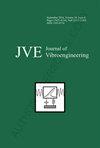嵌入式道岔区有轨电车-道岔耦合系统的动力相互作用
IF 0.9
Q4 ENGINEERING, MECHANICAL
引用次数: 0
摘要
嵌入式道岔是现代有轨电车系统嵌入式轨道网的关键设施之一。在本研究中,对嵌入式道岔的阻尼性能和轨道刚度进行了现场测试。基于道岔区轮轨接触理论,建立了有轨电车多刚体动力学模型和嵌入式道岔有限元动力学模型,并将两者耦合。其次,对有轨电车通过埋置道岔的动力响应进行了分析。结果表明,该道岔具有良好的阻尼性能。道岔和辙叉处变截面钢轨的高刚度会导致轮轨动力的增加。当有轨电车通过预埋道岔时,辙叉和道岔处的轮轨垂直力分别达到106.3和35.2kN的最大值;最大车轮脱轨系数为0.49,车轮减重率为0.57,均在本标准规定的安全限值内;车体最大横向和垂直振动加速度分别为0.38和0.71m/s2,满足舒适性要求;道岔处的轮轨磨耗功大于辙叉处的轮轨磨损功。本文章由计算机程序翻译,如有差异,请以英文原文为准。
Dynamic interactions of tram-turnout coupling system in embedded turnout area
Embedded turnout is one of the key facilities in the embedded track network of modern tram systems. In this study, the damping performance and track stiffness of an embedded turnout are tested on site. A multi-rigid body dynamics model of the tram and a finite-element dynamics model of the embedded turnout are established, and the two models are coupled based on the wheel-rail contact theory for the turnout area. Next, the dynamic responses of the tram passing through the embedded turnout are analyzed. The results show that the embedded turnout has favorable damping performance. The high stiffness of variable section rails at the switch and frog would lead to an increase in the wheel-rail dynamic force. When the tram passes through the embedded turnout, the wheel-rail vertical force reaches maximum values of 106.3 and 35.2 kN at the frog and switch, respectively; the maximum wheel derailment coefficient and wheel weight reduction rate are 0.49 and 0.57, respectively, which are within the safety limit specified in the Standards; the maximum lateral and vertical vibration accelerations of the tram body are 0.38 and 0.71 m/s2, respectively, satisfying the comfort requirements; the wheel–rail wear work at the switch is greater than that at the frog.
求助全文
通过发布文献求助,成功后即可免费获取论文全文。
去求助
来源期刊

Journal of Vibroengineering
工程技术-工程:机械
CiteScore
1.70
自引率
0.00%
发文量
97
审稿时长
4.5 months
期刊介绍:
Journal of VIBROENGINEERING (JVE) ISSN 1392-8716 is a prestigious peer reviewed International Journal specializing in theoretical and practical aspects of Vibration Engineering. It is indexed in ESCI and other major databases. Published every 1.5 months (8 times yearly), the journal attracts attention from the International Engineering Community.
 求助内容:
求助内容: 应助结果提醒方式:
应助结果提醒方式:


